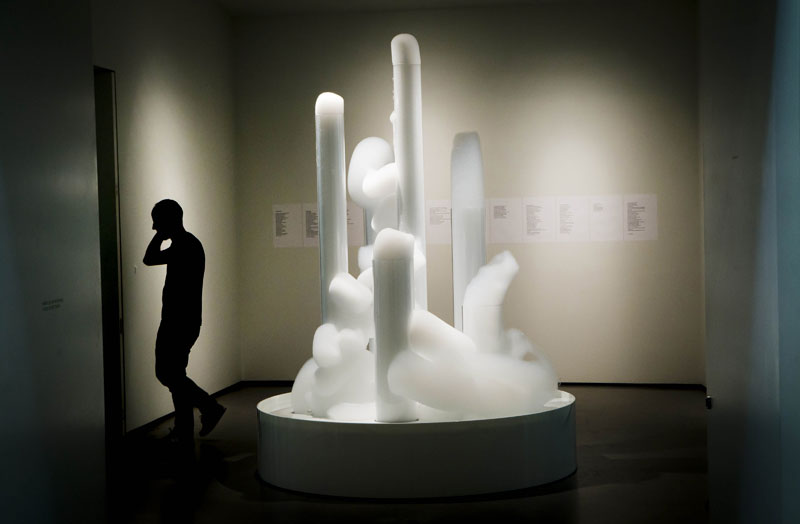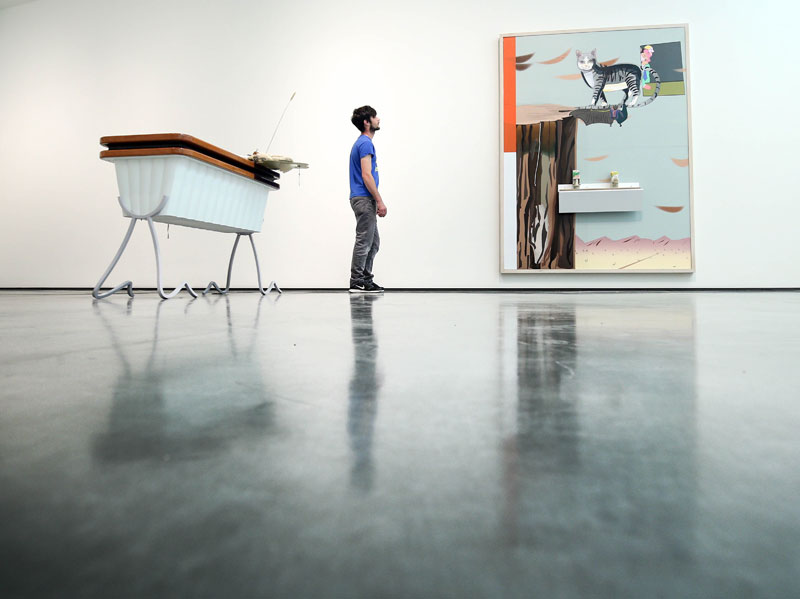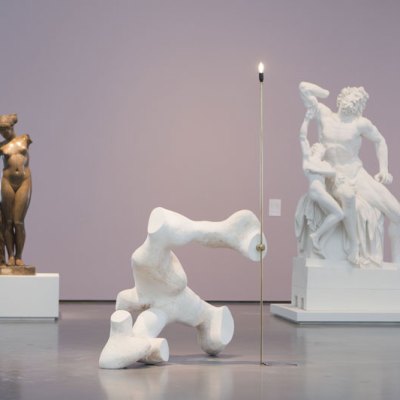Designed to showcase the breadth of sculptural practice in the UK today and to highlight the work of sculptors at any stage of their career, the new Hepworth Prize for Sculpture has more than lived up to its aims. In age terms, the shortlist runs from the 74-year-old David Medalla to the 31-year-old eventual winner Helen Marten; in materials from concrete and iron, to leather, light, and soap bubbles; and in subject matter, from mass extinction to internet cats. Altogether, the shortlist of Medalla and Marten with Steven Claydon and Phyllida Barlow make for an inaugural show that is by turns overwhelming, enchanting, funny, and as baffling as a Zen kōan. It is also – despite the generous egalitarian decision of Marten to share the prize with her fellow shortlistees – a striking argument for the worth of these kinds of prize, which draw attention not just to the artists, but to the galleries and regions that host them.
Cloud Canyons (1964-2016), David Medalla. Photo: Danny Lawson/PA Wire

It’s fitting for a show that revels in breadth and contradiction that the first work viewers encounter should be both the oldest and the most evanescent: a reconstruction of David Medalla’s 1964 Cloud Canyons. Continuously shifting at an almost imperceptible pace, its soft curves are produced by thick soap foam being extruded from Perspex columns of different heights; as they topple and fall, each column of foam drapes a new formal convolution over those below. The rate of extrusion and the rate of decay are slow enough that the piece manages at once to be in continuous movement, and to give an impression of greater stillness than static sculptures with similar forms – not least the Hepworths and Moores just next door on permanent display.
screestage (2013), Phyllida Barlow. Photo: Danny Lawson/PA Wire

If there is a problem, or at least a pitfall, with the Hepworth show, it’s the risk of comparing apples to oranges – which seems to be exemplified in the second room with Medalla’s A Stitch in Time. Here viewers are invited to sew small objects of their own into four colourful gauzes, an experiment in participatory art that, directly after Cloud Canyons merely feels scrappy and unsatisfying – an assemblage of receipts and used railway tickets. It suffers even more by comparison with the massive hulk of Phyllida Barlow’s screestage in the next room. Built like a cross between a decaying jetty and a slipping shelf of slate fragments, screestage fills three quarters of Barlow’s room, towering over you as you enter. Walk underneath its dark bulk, between its irregular supporting uprights and suspended, bouldery excrescences, and you slip out the other side to see its full surface revealed to you, paused in the act of collapse. It is an extraordinary piece – and, really, incomparable, with those around it.
Bluebutter Idles Bluebutter Idles and Part offering (new and amazingly sexual daughters) (2014), Helen Marten.

After screestage, it’s hard not to experience Helen Marten’s room as passing from the sublime to the ridiculous: from something akin to a rock formation, to a collection of cat memes. It is, though, a shock that for me quickly gave way to something like joy at just how intriguing and enjoyable Marten’s work is. The room is dominated by the four panels of Part offering – which repeat the same picture of a Roadrunner-esque desert cliff, towards which a smiling cat is walking, in mid-air, along the tightrope of its own tail. Each is customised with extra accoutrements, painted on, or attached to the surface: clay pipes here, coffee beans there. It’s silly stuff, but the play of shallowness and depth is dazzling. On one hand, these are sculptures whose central field is defiantly 2D: a cartoonish landscape silk-screened across smooth leather, with the cat deliberately planar in its balancing act. On the other, they summon up the depth that you find in a paradox or a kōan: a kind of Lewis Carroll nonsense vertigo evoked by that smiling cat. It is ‘post-internet art’ – in its meme-customisation, its random-non-random associative agglomerations, its repetitiveness – but in the best possible way. One panel is even adorned with what looks like a ‘captcha’ down one side; I picked out the blurred letters to read ‘chop suey’, which proved, I suppose, that I wasn’t a robot. But picking out exactly what is going on across Part offering as a whole isn’t half so easy – and that’s the charm.
‘Stochastic Conveyor (Transference) (2016) and ‘Like Shooting Sparrows in the Dark 3 (deterrent lure) (2016), Steven Laydon. Photo: Danny Lawson/PA Wire

Steven Claydon’s work in the exhibition’s final room shares the play and paradox found in Marten’s. Unlike Marten’s work, though, one feels that it’s possible to be in on the joke – as long as you know the key. Claydon’s greatest joy, it seems, is in the sculptural equivalent of ‘autoantonyms’ – those rare words that happen to be their own opposites. Along one wall is Like Shooting Sparrows in the Dark 3 (deterrent lure) – a row of lights shining at the frequency used both to stop drug-users from shooting up in public toilets and, it turns out, as a lure for deep-sea squid fishing. In Stochastic Conveyor (Transference) camera lenses are covered in gold in reference to a technique that helps museums take detailed photographs of tiny objects by covering them in the material. In Magnate (obelisk) shiny pennies dot a magnetic membrane like a starfield. The piece plays on the fact that price-rises in copper made pure copper pennies worth more as scrap than as currency. Only new pennies – which are deliberately adulterated with a ferrous core to be ‘worth’ less than a penny in real terms – will stick to the magnetic sheeting. Once one’s let in on the idea, Claydon’s work reveals its brilliance; but if one isn’t, it can easily seem hermetic. As with the rest of this year’s shortlist, though, it’s a joy to peel away its layers one by one, and find out what’s beneath.
‘The Hepworth Prize for Sculpture’ is at the Hepworth Wakefield until 19 February 2017.



